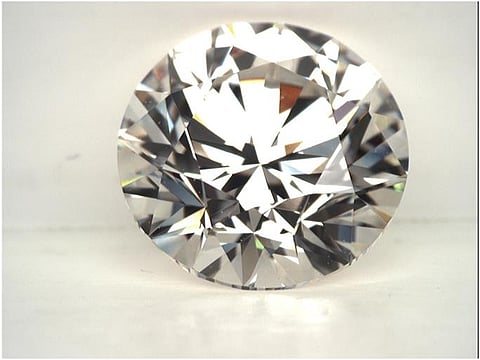

The sample was identified as Type IIa, meaning that it contains virtually no elements other than carbon. Diamonds of this type are always investigated extensively at HRD Antwerp’s Research department to verify that the stone is a natural diamond without any colour enhancements. This is of crucial importance, as diamonds that are colour-treated sell at significantly lower prices than their untreated counterparts.
During testing, HRD Antwerp scientists discovered that the diamond had in fact undergone High Pressure High Temperature (HPHT) colour treatment; a remarkable outcome, considering the stone was inscribed with a GIA laser inscription corresponding to a natural diamond grading report. The report made no mention of any colour treatments, which raised some questions about the authenticity of the inscription.
Upon closer examination, the HRD Antwerp graders noticed a few inconsistencies between the diamond and its supposed grading report, including clarity characteristics that were quite similar and could be easily mistaken during a standard loupe inspection. However, detailed microscopic investigation by an experienced grader revealed that this was not the same diamond described in the report. Although the stone’s carat weight, colour, cut, and final clarity grade (VS1) precisely matched the accompanying report, the clarity characteristics did not completely overlap. Since these characteristics are a unique fingerprint of the diamond, the inscription was conclusively identified as false.
The diamond at hand had been intentionally inscribed with a fake laser inscription to deceive the customer. The global guidelines for the diamond industry prohibit passing off a lab-grown diamond as natural without clearly and publicly declaring its origin.
Although such fraudulent activities are seen as exceptions rather than common practice, it stresses the important role of high-quality laboratories to uncover these issues.
“These examples of attempted fraud illustrate why it is so crucial to have the diamond grading report updated before completing a purchase, especially in instances where the buyer does not have a trusted connection with the seller,” stated Ellen Joncheere, CEO at HRD Antwerp.
To detect colour treatments, HRD Antwerp relies on years of extensive research and the most advanced technologies available to the industry. Any diamond submitted for certification is investigated with the greatest care to ensure the trust and confidence of customers.
HRD Antwerp only issues Treated Diamond Grading Reports for HPHT treated diamonds whose treatment is disclosed by the customer. HRD Antwerp’s Treated Diamond Grading Reports can be differentiated by their distinct grey colour to ensure they are not confused with the blue coloured Natural Diamond Grading Reports.
HRD Antwerp recommends that members of the trade who have any doubts about a diamond send it to a gem lab for verification.
Follow DiamondWorld on Instagram: @diamondworldnet
Follow DiamondWorld on Twitter: @diamondworldnet
Follow DiamondWorld on Facebook: @diamondworldnet
